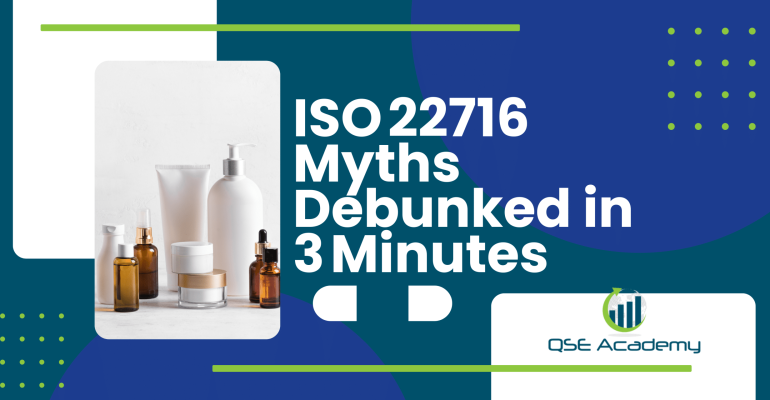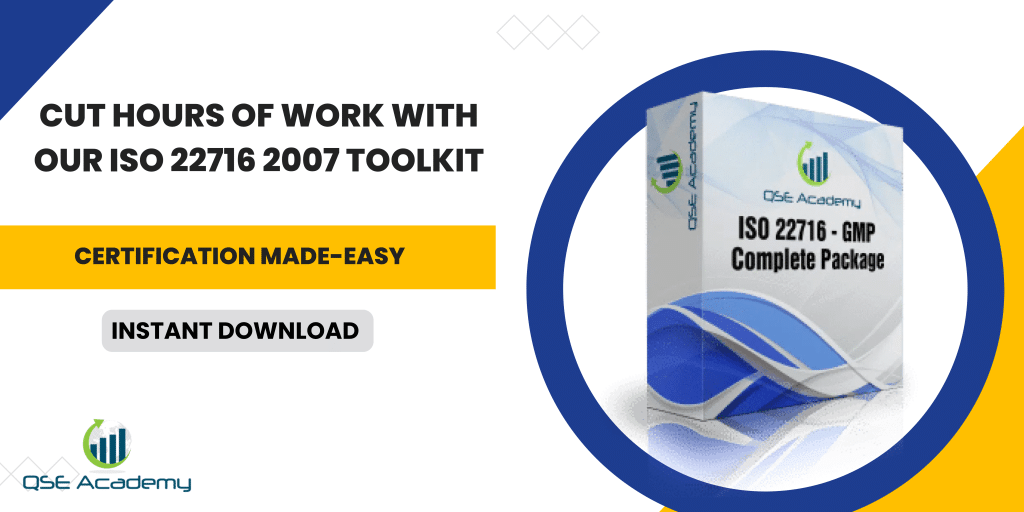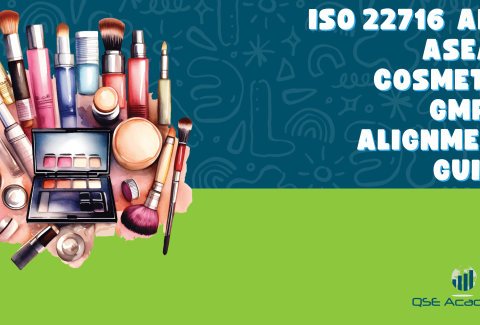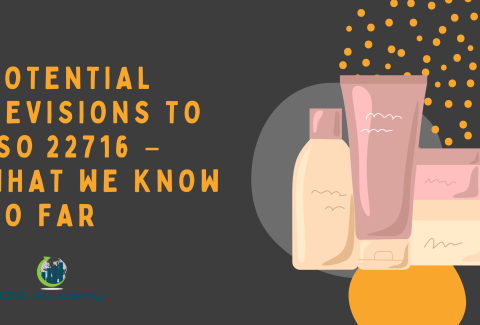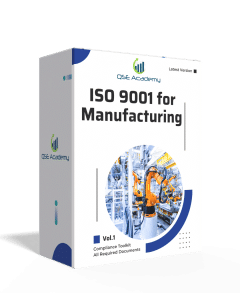ISO 22716 Myths Debunked in 3 Minutes
Last Updated on October 24, 2025 by Hafsa J.
Cutting Through the Confusion Around ISO 22716
If you’ve spent any time researching cosmetic compliance, you’ve probably come across ISO 22716 — and a whole lot of conflicting advice about it. I’ve seen manufacturers, small brands, and even distributors misunderstand what this standard actually means. Some think it’s a legal requirement, others assume it’s only for big factories, and a few believe it’s just paperwork with a fancy title.
In reality, ISO 22716 is one of the most practical tools a cosmetic business can use to stay compliant, organized, and trusted. But misinformation can cost you time, money, and credibility.
That’s why we’re going to clear the air — fast. In just a few minutes, I’ll walk you through the most common myths about ISO 22716 and the truths behind them. No jargon, no fluff — just straightforward answers that will help you see where the real value of GMP compliance lies.
Myth #1 – “ISO 22716 Certification Is Legally Mandatory in the EU”
This is probably the biggest misunderstanding I hear — and it’s easy to see why. The EU Regulation 1223/2009 makes Good Manufacturing Practice (GMP) mandatory for cosmetics, and ISO 22716 is the most recognized GMP guideline. So people assume certification is required by law.
Here’s the truth: you must follow GMP, but you don’t have to be ISO 22716 certified.
Certification is voluntary — a way to prove you meet GMP expectations. Regulators only care that your manufacturing follows GMP principles, not that you’ve paid for a third-party certificate.
Think of it like this: the law says you need a driver’s license (GMP compliance), but ISO 22716 certification is like taking advanced driving lessons — not required, but it shows you’re serious about doing things right.
Pro tip: Keep detailed records, SOPs, and cleaning logs aligned with ISO 22716. Even without certification, those documents demonstrate compliance when inspectors visit.
Common pitfall: I’ve seen companies rush to get certified thinking it’s legally required — spending thousands they didn’t need to. The smarter move is to first make sure your processes actually follow the standard. Certification can come later, once your system runs smoothly.
Myth #2 – “ISO 22716 Only Applies to Large Factories”
This one comes up almost every time I talk with small or artisan cosmetic producers. They’ll say, “We’re just a small workshop — ISO 22716 isn’t for us.” I get it. The term “Good Manufacturing Practice” sounds like something meant for massive industrial labs. But that couldn’t be further from the truth.
ISO 22716 was written to be scalable. That means it can fit your business, no matter the size. Whether you’re blending a few dozen jars of moisturizer in a small lab or running a fully automated plant, the principles stay the same: keep things clean, organized, traceable, and safe.
Pro tip: Start small but smart. Use simple SOPs, batch sheets, and cleaning logs that fit your setup. The goal isn’t complexity — it’s consistency.
Common pitfall: Small brands often assume regulators won’t look their way. But if you’re selling cosmetics in the EU, you fall under the same Regulation 1223/2009 as any large manufacturer. That means you must show you’re following GMP — and ISO 22716 gives you the perfect framework for that.
Example: A two-person soap business I worked with in Italy built a basic ISO 22716-style system using spreadsheets and clear labeling. When local authorities visited, they passed with zero findings. No certification, no expensive software — just solid practices done right.
So no, ISO 22716 isn’t just for big factories. It’s for anyone serious about producing safe, consistent cosmetics.
Myth #3 – “Once You’re Certified, You’re Set for Life”
I wish this one were true — it would make everyone’s life easier. But ISO 22716 certification isn’t a “get it and forget it” situation. In fact, it’s the opposite.
Certification is just the beginning. Once you’re certified, you’ll have surveillance audits every year and recertification every three years to make sure your GMP system is still being followed. Why? Because compliance isn’t static — people change, equipment wears down, and new products bring new risks.
Pro tip: Keep your system alive between audits. Schedule internal reviews every few months, check your records, and make sure SOPs still match reality. When auditors return, you’ll be ready — and more importantly, you’ll avoid nasty surprises.
Common pitfall: Some manufacturers relax after certification, thinking the hard part is over. Then, a year later, the auditor walks in and finds expired training records, missing logs, or outdated procedures. The certificate stays on the wall, but the system underneath has fallen apart.
Example: A certified cosmetics plant I once advised lost a key retail contract after a follow-up audit uncovered neglected GMP checks. They hadn’t updated their deviation log in months. It wasn’t malicious — they just assumed certification meant “job done.” It cost them both time and credibility to fix it.
ISO 22716 isn’t a trophy. It’s a routine. And the companies that treat it that way — consistently updating, checking, and improving — are the ones that stay compliant and competitive.
Myth #4 – “ISO 22716 Only Covers Production”
This one trips up even experienced manufacturers. They’ll say, “Our production team follows ISO 22716 — we’re covered.” But the truth is, this standard reaches far beyond the production line.
ISO 22716 covers the entire product lifecycle — from raw materials and packaging to storage, labeling, shipping, and even handling returns. Why? Because a perfect production process means nothing if products are stored incorrectly, mislabeled, or contaminated after filling.
For example, imagine your team follows every GMP step during manufacturing, but your warehouse lacks temperature control or proper pest prevention. That’s still a GMP failure — and it can undo all the good work done in production.
Pro tip: Include logistics, packaging, and warehousing staff in your GMP training. Everyone who touches the product plays a role in compliance.
Common pitfall: Many companies stop documenting once products leave the production floor. But ISO 22716 requires traceability at every step — that includes storage conditions, transport checks, and product release records.
Example: A distributor I advised in Germany passed their production audit with flying colors but failed a follow-up because warehouse temperature logs were missing. Fixing the issue was simple — adding daily checks and a clear SOP — but it proved how easily oversight happens outside production.
The lesson? GMP doesn’t stop when the batch is made. ISO 22716 ensures your product stays safe, consistent, and traceable until it reaches the customer.
Myth #5 – “ISO 22716 Is Just About Paperwork”
I hear this one all the time: “It’s just documents and checklists, right?” Not even close.
Yes, ISO 22716 involves documentation — but paperwork isn’t the goal. It’s the evidence that your system works. The real goal is control, consistency, and traceability.
When done right, documentation doesn’t slow you down — it saves you time. Think about it: a clear SOP prevents confusion, a batch record tells you exactly what went wrong when something fails, and a training log keeps regulators off your back. Every piece of “paperwork” has a purpose.
Pro tip: Write procedures that people actually want to follow. Keep them short, visual, and practical. The best SOPs are written with your operators, not just for them.
Common pitfall: Copying generic ISO templates from the internet without tailoring them to your actual workflow. It might impress an auditor once, but it won’t help your team day to day. And sooner or later, the disconnect will show.
Example: One cosmetics lab I worked with used to struggle with downtime and rework because cleaning tasks weren’t standardized. After rewriting their cleaning SOPs with staff input, downtime dropped by half. Same team, same equipment — just clearer instructions that people could actually follow.
ISO 22716 isn’t about creating paperwork — it’s about creating clarity. The documents are simply proof that your process is solid, safe, and repeatable.
Myth #6 – “GMP and ISO 22716 Are the Same Thing”
This one sounds believable because the two terms are used together all the time — but they’re not the same thing. GMP (Good Manufacturing Practice) is the principle, and ISO 22716 is the playbook that helps you apply that principle consistently in cosmetics.
Here’s the distinction I always make with clients:
-
GMP tells you what you must achieve — safe, controlled, and hygienic production.
-
ISO 22716 tells you how to get there — with structured procedures, records, and responsibilities.
Pro tip: Think of GMP as the goal and ISO 22716 as the method. When inspectors ask how you ensure GMP compliance, your ISO 22716 documentation becomes your evidence.
Common pitfall: Some manufacturers tell regulators, “We follow GMP” — but when asked for proof, they can’t produce records or SOPs aligned with ISO 22716. Without structure, “following GMP” is just a claim, not compliance.
Example: A cosmetics company I supported in Spain believed their operations met GMP because they maintained cleanliness and used quality raw materials. But once we mapped their activities against ISO 22716 clauses, we found major gaps in traceability and labeling control. After applying the ISO framework, they didn’t just pass their EU audit — they actually reduced batch rework by 30%.
So while GMP and ISO 22716 go hand in hand, it’s ISO 22716 that turns GMP theory into auditable, repeatable, and provable practice.
FAQs – Quick Clarifications
1. Do I need ISO 22716 certification to sell cosmetics in the EU?
No, you don’t. What you do need is proof that your products are manufactured according to Good Manufacturing Practice (GMP). ISO 22716 is simply the recognized guideline for demonstrating that compliance. Certification helps with credibility, but documentation and discipline matter more than the certificate itself.
2. Is ISO 22716 too complicated for small producers?
Not at all. ISO 22716 scales beautifully. You can start small — clear labeling, cleaning records, ingredient tracking — and build from there. I’ve seen one-person operations satisfy EU inspectors just by showing consistent records and hygiene control. The standard’s goal is clarity, not complexity.
3. How often should I review or update my GMP system?
At least once a year — or sooner if you change formulas, equipment, suppliers, or production layout. ISO 22716 isn’t a one-time setup; it’s a living system. Regular reviews keep your documentation aligned with reality and make audits painless.
Focus on Facts, Not Myths
When it comes to ISO 22716, most of the fear and confusion I see comes from misunderstanding what the standard really is. It’s not a burden or a bureaucratic exercise — it’s a framework that keeps your cosmetics safe, your processes efficient, and your compliance defensible.
The truth is simple: GMP isn’t optional, but ISO 22716 makes it achievable. Whether you’re a global brand or a growing startup, following this standard gives you the structure to operate confidently, pass inspections, and earn customer trust.
Pro tip: Don’t waste time chasing myths or shortcuts. Focus on building a clean, well-documented, and consistent system — that’s what inspectors, partners, and clients all want to see.
At QSE Academy, we’ve helped manufacturers worldwide separate fact from fiction, implement ISO 22716 correctly, and turn compliance into a real competitive advantage.
If you’re ready to simplify your approach and see where you stand, download our “ISO 22716 Myth-to-Fact Checklist” — it’ll show you exactly which areas need clarity, not complexity.
Because in cosmetics manufacturing, truth beats rumor every time.
Whether it’s ISO 9001, ISO 22000, or the cosmetics-focused ISO 22716, I’ve spent my career I’m not here to call myself an expert—I prefer “enthusiast” because I truly love what I do. When I’m not writing about standards, you’ll probably find me playing Piano 🎹, connecting with people, or diving into my next big project💫. I’m an engineer specialized in the food and agricultural industry
make ISO standards less intimidating and more approachable for everyone.
turning complex jargon into clear, actionable steps that businesses can actually use.
There’s something incredibly rewarding about helping people navigate food safety and quality management systems
in a way that feels simple, practical, and even enjoyable.
I have a Master’s in QHSE management and over 12 years of experience as a Quality Manager
I’ve helped more than 15 companies implement ISO 9001, ISO 22000, ISO 22716, GMP, and other standards
My clients include food producers, cosmetics manufacturers, laboratories, and service companies
I believe quality systems should be simple, useful, and efficient.

